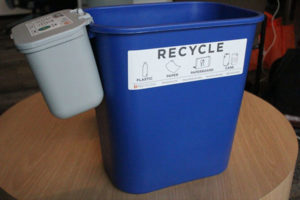 You’re receiving a My Tiny Trash bin! Your blue recycling bin can now be used for clean plastic, aluminum and steel cans, and cardboard, as well as paper. Your three-quart Tiny Trash bin attaches on the side: that’s where you can put tissues, wrappers, foil and more. When both are full, find the nearest central waste station near you and dump your trash in the landfill waste bin. Then sort your recyclables by putting cans and plastic containers in the green recycling bin, paper in the blue bin, and setting flattened corrugated cardboard boxes between or beside the bins. Facilities Services workers will no longer be emptying your desk-side waste receptacles.
You’re receiving a My Tiny Trash bin! Your blue recycling bin can now be used for clean plastic, aluminum and steel cans, and cardboard, as well as paper. Your three-quart Tiny Trash bin attaches on the side: that’s where you can put tissues, wrappers, foil and more. When both are full, find the nearest central waste station near you and dump your trash in the landfill waste bin. Then sort your recyclables by putting cans and plastic containers in the green recycling bin, paper in the blue bin, and setting flattened corrugated cardboard boxes between or beside the bins. Facilities Services workers will no longer be emptying your desk-side waste receptacles.
The goal of My Tiny Trash is to increase recycling rates and decrease landfill waste by providing waste containers that accurately reflect the waste stream (the EPA estimates that about 75% of American waste can be recycled.) The program is meant to conserve resources by eliminating the need for plastic trash liners at desk-side bins. It also makes individuals responsible for the waste they produce which has been reported to increase recycling awareness.
Tiny Trash programs like these have existed in local government buildings, businesses, and universities across the U.S. and Canada since the 1990s. UT Recycling started investigating the program as a way to increase UT’s waste diversion rate by increasing workplace recycling, an important, but often overlooked aspect of recycling. Studies show that while 77% of people report recycling at home, only 49% report recycling at the office.
No. Facilities Services workers will still be emptying trash and recycling from the centralized waste stations in your building on a daily basis. The only change is that you are now responsible for emptying your own desk-side waste and recycling containers.
The answer is: yes and no. One problem with workplace waste is that a HUGE percentage of recyclable materials ends up in the trash. With your new recycling bin, you might find that much of what you were throwing away can actually be recycled. For larger items or dirty food waste, you may simply have to make a few more trips to the central waste station, but short breaks throughout the day are shown to be beneficial to your health and concentration.
While the program will not affect classrooms or shared spaces, the goal is to implement My Tiny Trash in all of UT’s 100+ office buildings by summer of 2019. That includes the offices of upper administrators. In fact, Andy Holt Tower will be one of the first buildings to implement the program.
YES!
When these programs are implemented, institutions see:
- Increased recycling rates
- Reduced landfill waste
- A reduction in plastic trash liner usage, which saves additional materials and money
- Employee reports of increased recycling awareness
Here on Rocky Top, a pilot program in the Facilities Services Complex contributed to a 66% recycling rate in that building. That’s nearly double the campus-wide average of just over 33%.
If you still don’t believe us, here’s some evidence from other universities:
| Institution | Implementation Date | Result |
|---|---|---|
| Dartmouth University | 2010 | After one year of the program, trash was reduced by 200 tons and recycling increased by one-third. |
| Stanford University | 2012 | A pilot program saw a 14% recycling increase with a 30% increase in paper recycling. |
| Sonoma State University | 2006 | In one year of the program, the campus recycling rate increased by 55%. |
| University of Iowa | 2013 | Certain buildings on campus with the program saw 20% increases in recycling and a 94% reduction in plastic trash liner usage. |
| University of Minnesota, Duluth | 2014 | Landfill waste decreased by 20% and the amount of recyclable materials in the trash decreased by 14%. |
| University of North Carolina, Charlotte | 2011 | Recycling rates increased by 20% and the university saved $13,000 annually on trash bag liners |
| University of Southern Maine | 2013 | Between 2012 and 2013, landfill waste dropped 5.5%. |
No, this is not a plan to lay off workers in the Facilities Services department—the work they do is incredibly valuable. This initiative will not decrease the number of jobs in the department.
Custodial workers will now have more time to perform professional custodial work like cleaning shared spaces and bathrooms, polishing floors and disinfecting commonly used objects. Workflow will change according to the needs of each building.